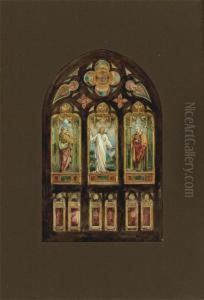Mary Elizabeth Tillinghast Paintings
Mary Elizabeth Tillinghast was an American artist and designer born on October 6, 1845, in New York City. She came from a well-to-do family, which allowed her to pursue her interests in art and culture from a young age. Her early education in art began at the prestigious Cooper Union for the Advancement of Science and Art in New York, where she honed her skills and developed her artistic sensibilities. Tillinghast's talent became evident early on, and her work soon gained recognition.
After her initial education, Tillinghast continued her studies abroad, which was quite an exceptional move for a woman of her time. She studied in Paris under renowned artists such as Emile-Auguste Carolus-Duran and Raphaël Collin. This period was crucial for her development as an artist, as she was exposed to the rich tapestry of European art and the various movements that were emerging at the time. Her exposure to European art, especially the stained glass of medieval Europe, would later influence her career profoundly.
Tillinghast returned to the United States and established herself in New York City, where she began her professional career as an artist. She worked across various mediums but is perhaps best known for her work in stained glass. In the 1880s, she opened her own studio, becoming one of the first American women to run a professional stained glass studio. Her innovative designs and exceptional craftsmanship earned her numerous commissions, including work for churches and other institutions.
Her work was characterized by a combination of traditional Gothic and Renaissance styles with an American twist, creating unique pieces that were both reverent to the past and reflective of the New World's spirit. Tillinghast was also a talented painter and illustrator, contributing to publications and exhibiting her works at art shows. Despite the challenges faced by women in the art world during her time, Tillinghast's reputation and success grew.
Mary Elizabeth Tillinghast's contribution to the arts was significant, and her legacy is seen in the stained glass windows that adorn many buildings across the United States. She was a pioneer for women in the arts, breaking barriers and setting a standard for the generations that followed. Tillinghast passed away on December 3, 1912, in New York City, leaving behind an enduring body of work that continues to be celebrated for its beauty and craftsmanship.
